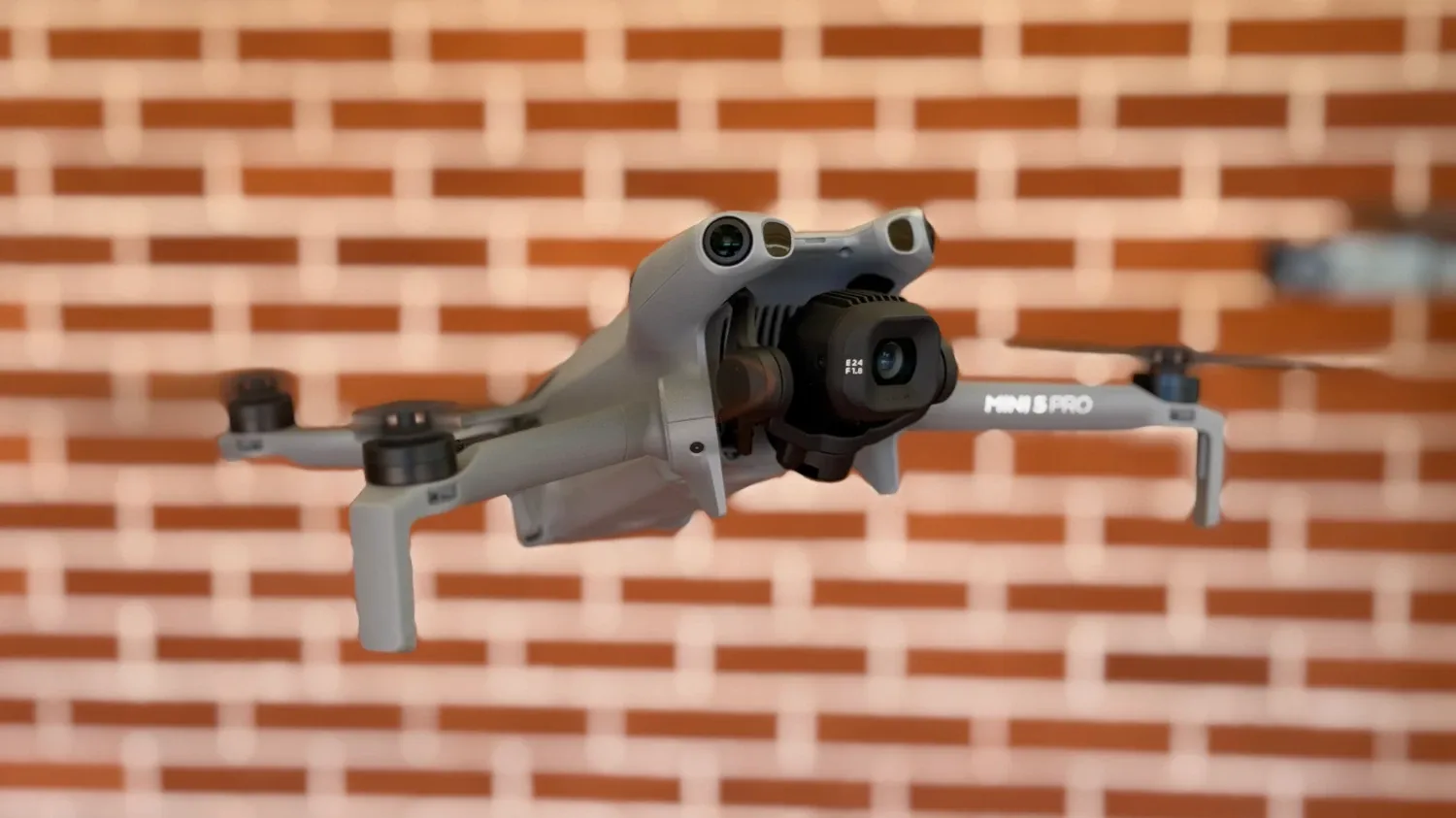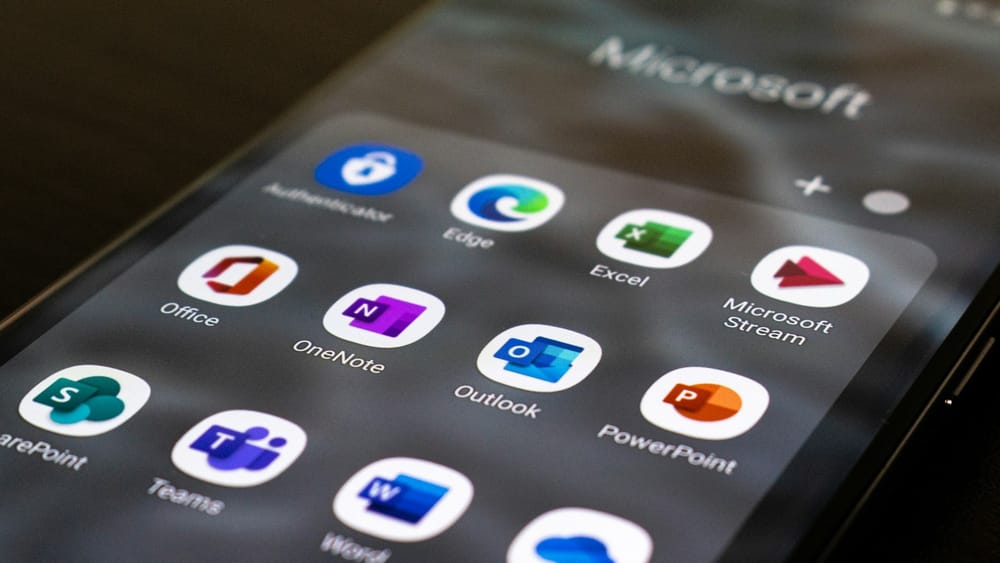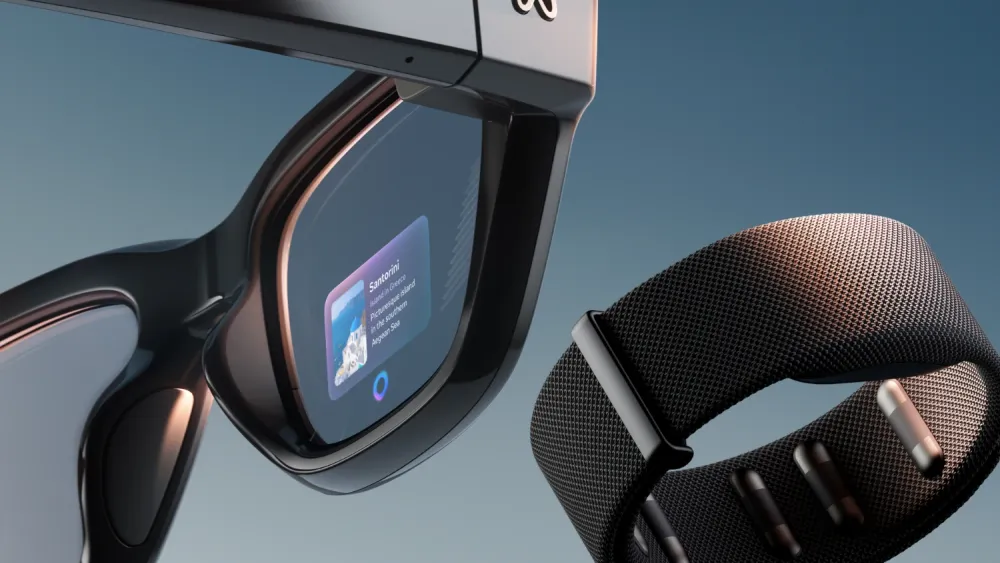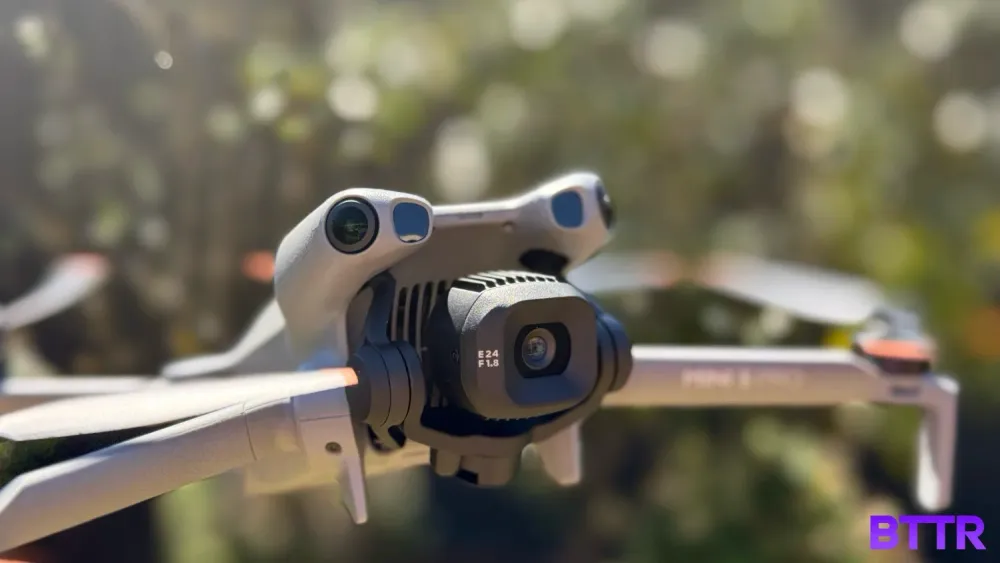The DJI Mini 5 Pro delivers genuinely professional imaging quality in a pocket-sized package, with a 1-inch sensor that rivals much larger drones and LiDAR-enhanced obstacle avoidance that inspires confidence. But some odd design decisions leave this sitting just above the 250-gram weight, which creates confusion around regulations and registration requirements.
- Outstanding 1-inch 50MP sensor produces flagship-level image quality
- Omnidirectional obstacle sensing with forward LiDAR works well
- Exceptional portability at 254g
- Four grams over sub-250g status, so may require registration
- Lightweight design makes it less stable in moderate wind
- Digital zoom quality degrades rapidly
My droning experience has been heavily focused on the smaller, lighter, entry-level space. There’s been a natural progression from the DJI Neo last year (which was one of my favourite products of the year) to the DJI Flip earlier this year.
The DJI Mini 5 Pro feels like a massive step-up, despite its diminutive size. While both the Neo and the Flip boast controller-free flight modes straight out of the gate, the Mini 5 Pro brings professional features to a smaller frame.
However, some controversial decisions made by DJI regarding the design of this drone mean that, despite claims it fits into the sub-250g micro-drone category, its 254g weight means it is classified as a “small restricted RPA” by CASA, the Civil Aviation Safety Authority.
For hobbyists, this created a spot of confusion about whether you would be required to register the drone with CASA, though DroneXL confirmed with CASA that registration and accreditation are only required for this drone if you intend to use it commercially or as part of your job.
Now that the dust has settled a bit, I feel that weighing the Mini 5 Pro to creep up over 250 grams is going to hurt sales, thanks to this confusion. Which is a shame because this is a fantastic little drone.
@bttr_reviews POV: DJI just dropped the most OP mini drone ever 🤯 ✅ 1-inch sensor (bigger = better quality) ✅ Gimbal does a full 360° spin 🌪️ ✅ Sees in the dark with LiDAR 👀 ✅ 52 minutes battery life (WHAT?!) ✅ 20km range (why so far tho? 😭) ✅ Downloads files while OFF 📱 This beast is about to change the game for content creators 🔥 The 14 stops HDR + portrait mode combo is chef's kiss 💋 Who's maxing out their credit card for this? 💸 #DJIMini5Pro #DroneUnboxing #TechTok #ContentCreator #DJI #DroneLife #TechReview #Viral #FYP #Cinematography #HDR
♬ original sound - bttr_reviews
What makes the DJI Mini 5 Pro stand out?
If you consider that consumer drones are pretty much just flying cameras, then the fact the Mini 5 pro features a 1-inch CMOS sensor is a game-changer.
That sized sensor has historically only been available in much larger models, and it brings with it impressive performance. The DJI Mini 5 Pro can take 50 megapixel photos and record 4K video at 60 fps, with HDR recording over 14 stops in auto mode.
This makes it the ideal partner for gorgeous photos and video in what you would typically deem “difficult” lighting situations. Think sunrise and sunset, or capturing darkened scenes in the middle of the day.
The gimbal that houses the camera can now roll up to 225 degrees, which allows you to shoot both horizontal and vertical video.
Beyond the camera, DJI has managed to make the Mini 5 Pro compact and lightweight like previous generations, with folding arms that help the drone pack up nicely for easy transportation.
Being a “Pro” model, this isn’t designed for hobbyists, though they will certainly get their fair share of performance from the drone. Instead, its improved LiDAR system for obstacle avoidance makes it a great option for more professional users, like real estate agents or professional videographers.
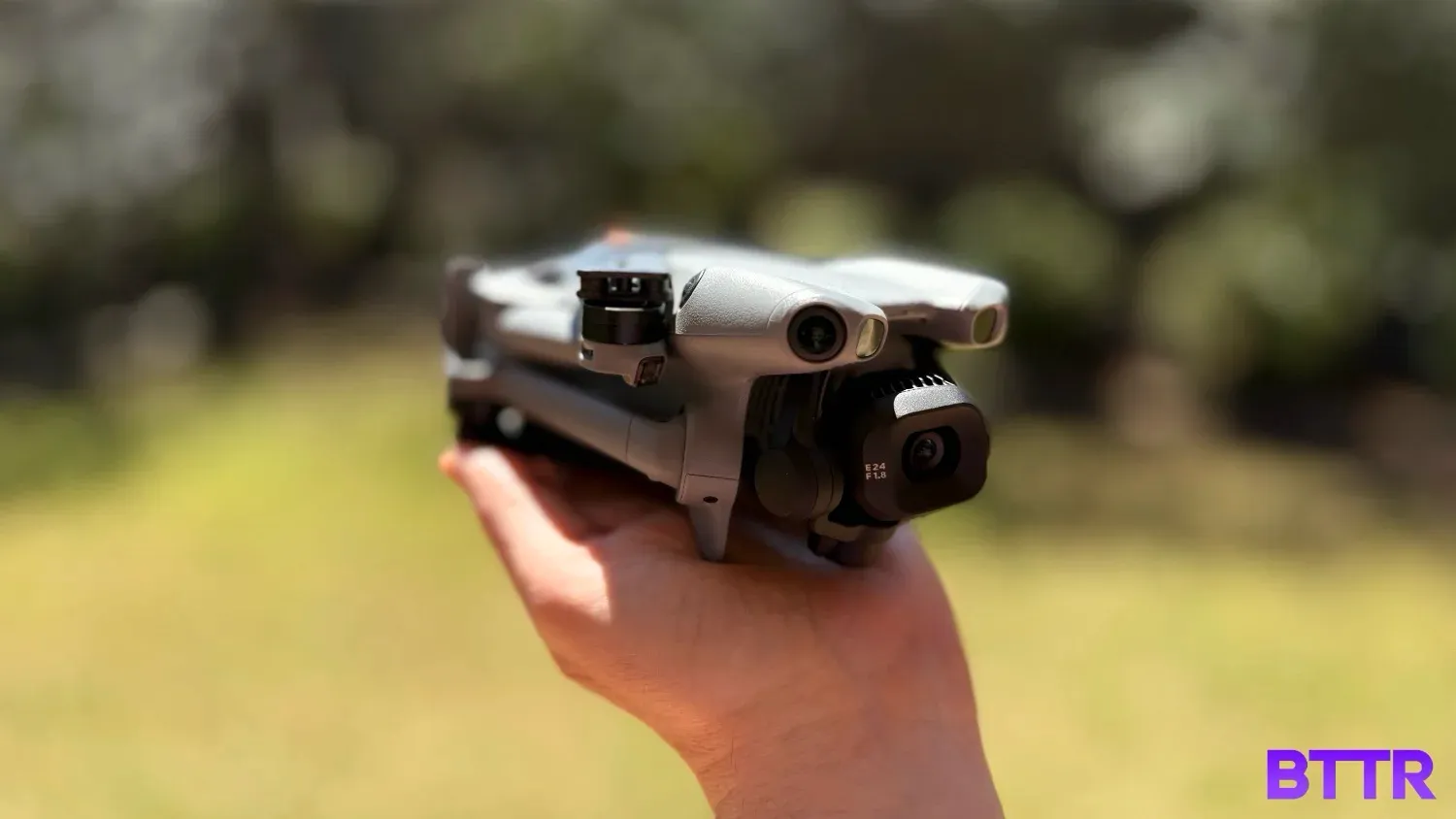
Specs
| DJI Mini 5 Pro Technical Specifications | |
|---|---|
| Physical Dimensions | |
| Weight | 249.9g (standard battery) |
| Dimensions (Folded) | 157 × 95 × 68 mm |
| Dimensions (Unfolded) | 304 × 380 × 91 mm (with propellers) 255 × 181 × 91 mm (alternate measurement) |
| Operating Temperature | -10°C to 40°C |
| Wind Resistance | 12 m/s (43.2 km/h) |
| Camera System | |
| Sensor | 1-inch CMOS, 50MP |
| Effective Pixels | 50MP |
| Lens | 24mm (35mm equivalent), f/1.8 aperture, 84° FOV |
| Focus Range | 0.5m to infinity |
| Digital Zoom | 3x (12MP photos, 4K video), 4x (FHD video) |
| Med-Tele Mode | 48mm equivalent (2x digital zoom) |
| Photo Resolution | 8192 × 6144 pixels |
| Photo Formats | JPEG, RAW (DNG) |
| Gimbal | 3-axis mechanical, 225° rotation range |
| Gimbal Tilt | -90° to +60° |
| Max Tilt Angle | 38° |
| Video Capabilities | |
| Max Video Resolution | 5.4K/30fps, 4K/120fps, 4K/60fps HDR |
| Slow Motion | 4K at 120fps, FHD at 240fps |
| Video Formats | H.265 (HEVC), H.264 |
| Color Profiles | Normal, D-Log M, HLG (10-bit) |
| Dynamic Range | Up to 14 stops |
| Max ISO | 12,800 (Normal mode), 3,200 (D-Log M/HLG) |
| Flight Performance | |
| Max Flight Time | 36 minutes (standard battery) 52 minutes (Plus battery - not available in EU) |
| Typical Flight Time | 20-22 minutes (real-world with 4K/60fps recording) |
| Max Flight Distance | 21km (standard battery) 32km (Plus battery) |
| Max Speed (Sport Mode) | 18 m/s (64.8 km/h) standard battery 19 m/s (68 km/h) Plus battery |
| Max Ascent Speed | 10 m/s (36 km/h) |
| Max Descent Speed | 6 m/s (21.6 km/h) |
| Tracking Speed | Up to 15 m/s (54 km/h) |
| Battery | |
| Standard Battery | 2,788 mAh, 7.16V, 19.52 Wh (Li-ion) |
| Plus Battery | 4,680 mAh, 7V, 33.51 Wh (Li-ion) Not available in EU, pushes weight over 250g |
| Charging Temperature | 5°C to 40°C |
| Charging Time (Single) | Under 50 minutes (65W charger) |
| Charging Time (3 Batteries) | 115 minutes (Two-Way Charging Hub + 65W charger) |
| Battery Compatibility | Backward compatible with Mini 3 Pro and Mini 4 Pro batteries |
| Obstacle Avoidance & Safety | |
| Obstacle Sensing | Omnidirectional (360°) |
| Forward Sensors | LiDAR + fisheye cameras |
| Rear Sensors | Fisheye cameras |
| Bottom Sensors | Binocular lenses + 3D infrared sensor |
| Nightscape Detection | Yes, with LiDAR-enhanced low-light capability |
| GNSS | GPS, Galileo, BeiDou |
| Transmission & Connectivity | |
| Transmission System | DJI O4+ (OcuSync 4 Plus) |
| Max Transmission Range | 20km (FCC), 10km (CE) |
| Live View Quality | 1080p/60fps |
| Video Bitrate | 10-bit transmission |
| Latency | ~120ms |
| Antenna Configuration | 4 antennas (2T4R) |
| Wi-Fi | Wi-Fi 6 (802.11ax), 2.4GHz/5.8GHz, up to 100 MB/s download |
| Bluetooth | Bluetooth 5.4 |
| Storage | |
| Internal Storage | 42GB (exFAT file system) |
| External Storage | microSD card (recommended: Lexar/Kingston A2 V30, up to 1TB) |
| File Transfer | Off-state USB-C transfer supported (no power required) |
| Intelligent Features | |
| ActiveTrack | 360° ActiveTrack (Standard and Cycling modes) |
| QuickShots | Multiple automated flight modes |
| HDR Bracketing | 7-shot AEB (Auto Exposure Bracketing) |
| Vertical Shooting | True 90° vertical mode (full sensor utilization) |
| Dynamic Home Point | Yes (follows moving launch point) |
| Safe Takeoff/Return | Yes, without satellite signal (using memorized routes) |
| Controllers | |
| Standard Options | RC-N3 (phone holder) or RC 2 (built-in screen) |
| Optional Controller | RC Pro 2 (2000-nit ultra-bright screen, sold separately) |
Design and build quality
The Mini 5 Pro is small, but like the Flip, it opens up to be a much larger drone than you expect.
One key difference here, though, is that the propellers are exposed, which helps on the weight front.
The rear arms simply fold out horizontally, while the front arms rotate around, and when folded, there’s a gimbal guard and strap that helps hold the entire drone together for easier transport.
Around the drone, including on the front for the first time, are LiDAR sensors that help make the drone safer to fly. These blend effortlessly into the drone’s grey and black design, and do make it very difficult to crash while flying.
The $1,699 Fly More combo I was sent to review included the drone, the RC 2 wireless controller, three intelligent flight batteries, a two-way charging hub, an ND filter set and a shoulder bag to carry the drone. For an extra $100 you can get the combo with the larger batteries, or there’s a $1,419 bundle with the more basic RC-N3 controller, which uses your phone as a screen.
Perhaps the most interesting aspect of the Mini Pro 5’s design is the weight. There was a lot of discussion online when the drone’s specs were announced, as the 254 gram weight takes it outside the sub-250 gram category.
According to reports, a part of the reason the drone is over the weight limit is the addition of a speaker, which appears to play a jingle when you power up the drone.
When it comes down to it, the few grams of additional weight don’t impact performance, and if you fly in Australia for fun, shouldn’t make a difference to your hobby.
But if you travel internationally, or use the drone for work, you will need to take extra care to ensure the Mini 5 Pro is legal at your destination before you take off.
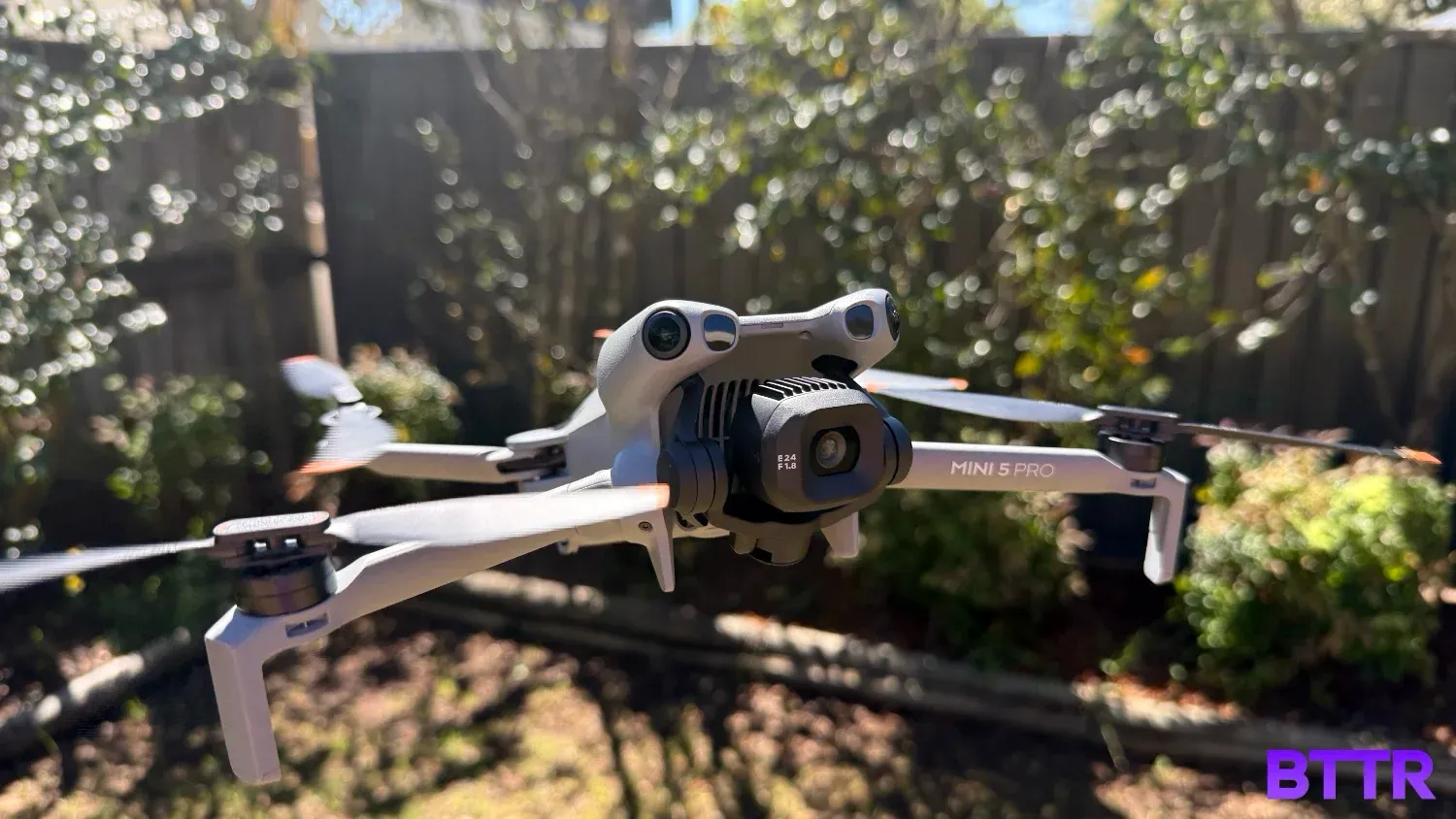
Flight performance and handling
I used the bundled RC2 controller to fly the Mini Pro 5, and it was great.
The drone is really responsive, and while it does take a bit of time to get used to flying, once you get the hang of it, the Mini Pro 5 is a joy to fly.
But the real benefit of using a DJI drone is taking advantage of features like ActiveTrack, which let you follow and track a moving object for cinematic shots.
This is probably the biggest reason for novice flyers to step up from a Neo or Flip if I’m honest. Because with the Mini 5 Por, the included LiDAR sensors make it really difficult to crash.
When I tested the DJI Neo, I used the Follow function while wandering through trees in local bushland, but occasionally, the drone hit a branch and fell to the ground.
With the Mini 5, the sensors help it more easily avoid obstacles like that. What’s more, even if you try to crash into a stationary object, the sensors will prevent it from happening.
That’s true even if you’re flying at speed. The Mini 5 Pro will pull up and stop impressively when its sensors detect a collision.
The LiDAR sensors should also help the drone if flying in low-light conditions. I didn’t really test this out, though. There are limitations on what you can do with recreational drone flying, and one of them is not flying at night.
It does come in handy with the Return to Home feature, which sees the drone follow its path back to where it took off when the battery starts running low. Being able to keep your drone under control even if the battery is at risk is a great feature.
Despite its diminutive size and weight, the Mini 5 Pro is pretty stable. I didn’t test it in super windy conditions, but it managed to withstand the occasional gusts when I took it out.
DJI promises 10-bit HDR video feed up to 20 km away, but I honestly didn’t feel comfortable even attempting to reach that kind of range.
Camera quality and footage
The Mini 5 Pro has the best image quality of any drone I’ve tested. Admittedly, that’s a relatively small basket of products, but for the price tag of this drone, you get impressive performance.
4K video is crisp and detailed, with good colour reproduction and impressive HDR performance.
If you’re a professional and need the best possible image quality, the Mini 5 Pro supports D-Log M and HLG colour profiles, while those who want to capture slow-motion can enjoy 4K 120 fps.
Photographers, meanwhile, can shoot in RAW to manage colour more effectively in post-processing.
The gimbal is fantastic, with video exceptionally smooth, even as the drone moves quickly.
And the fact you can easily rotate the gimbal to record vertical video is a massive boon for those of us who prefer to record vertical video for TikTok, Instagram Reels or YouTube Shorts.
You get 42 GB of on-board storage, with easy access to the MicroSD card slot at the rear of the drone. That should be enough for about an hour’s worth of 4K footage, which is a fantastic starting point for a really portable drone.
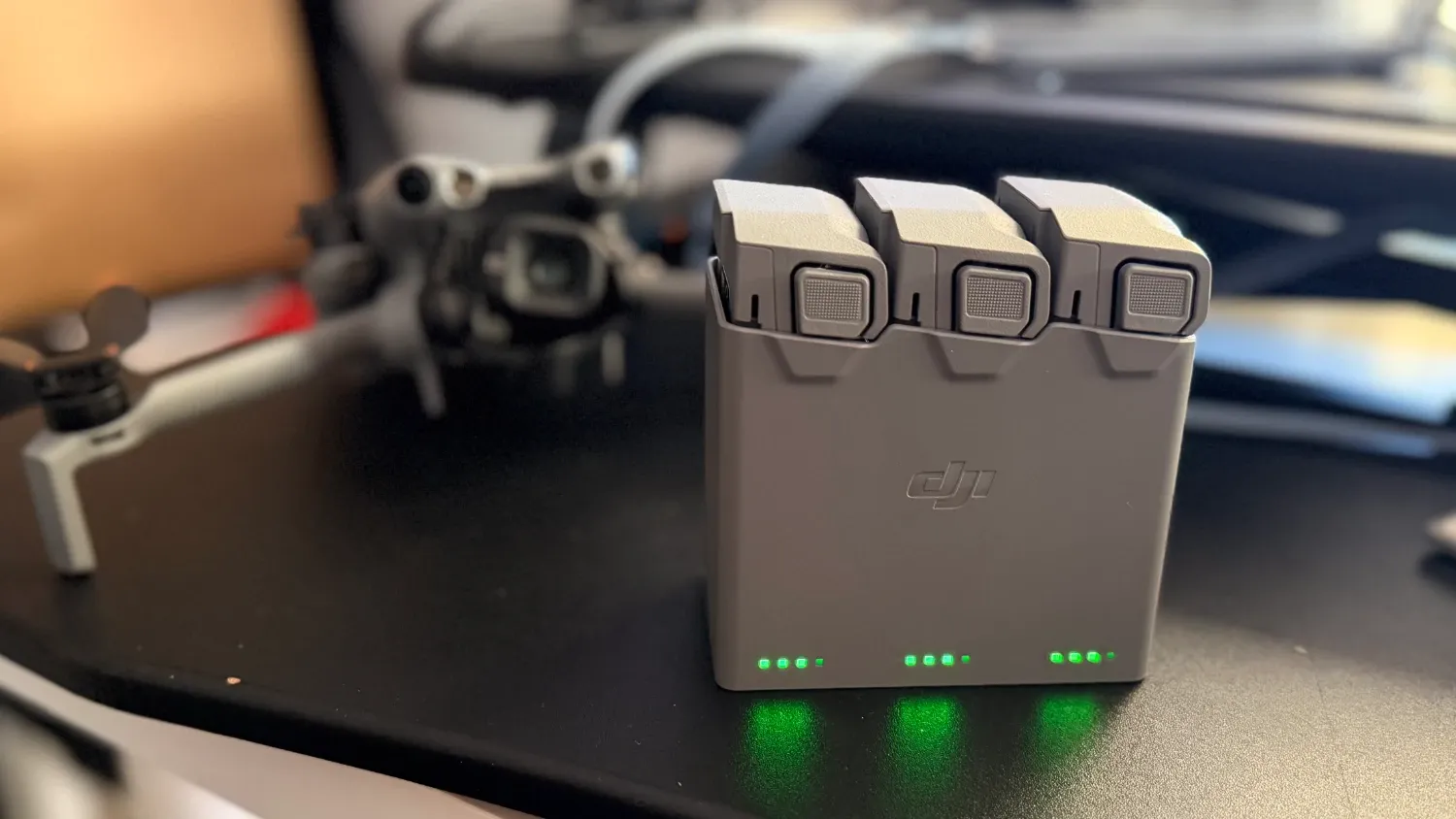
Battery Life and Charging
There are two battery options for the Mini 5 Pro. The Fly More pack I reviewed had the standard Intelligent Flight Batteries included, which promise up to 36 minutes of flight time per battery.
The more premium option comes with the Intelligent Flight Battery Plus, which pushes the maximum flight time to 52 minutes, but weighs a bit more (and remember, weight is imperative here).
In my testing, I typically got about 25 minutes or so per battery, but as you would expect, it depended on what I was doing with the drone. When you’re actually using the camera, the battery drops down quicker, as you might expect.
What I did appreciate was the two-way charging solution that comes in the Fly More pack. Essentially, this offers quick charging for all three bundled batteries in sequence, but can also be used as a power brick for your phone if you find you’re in need.
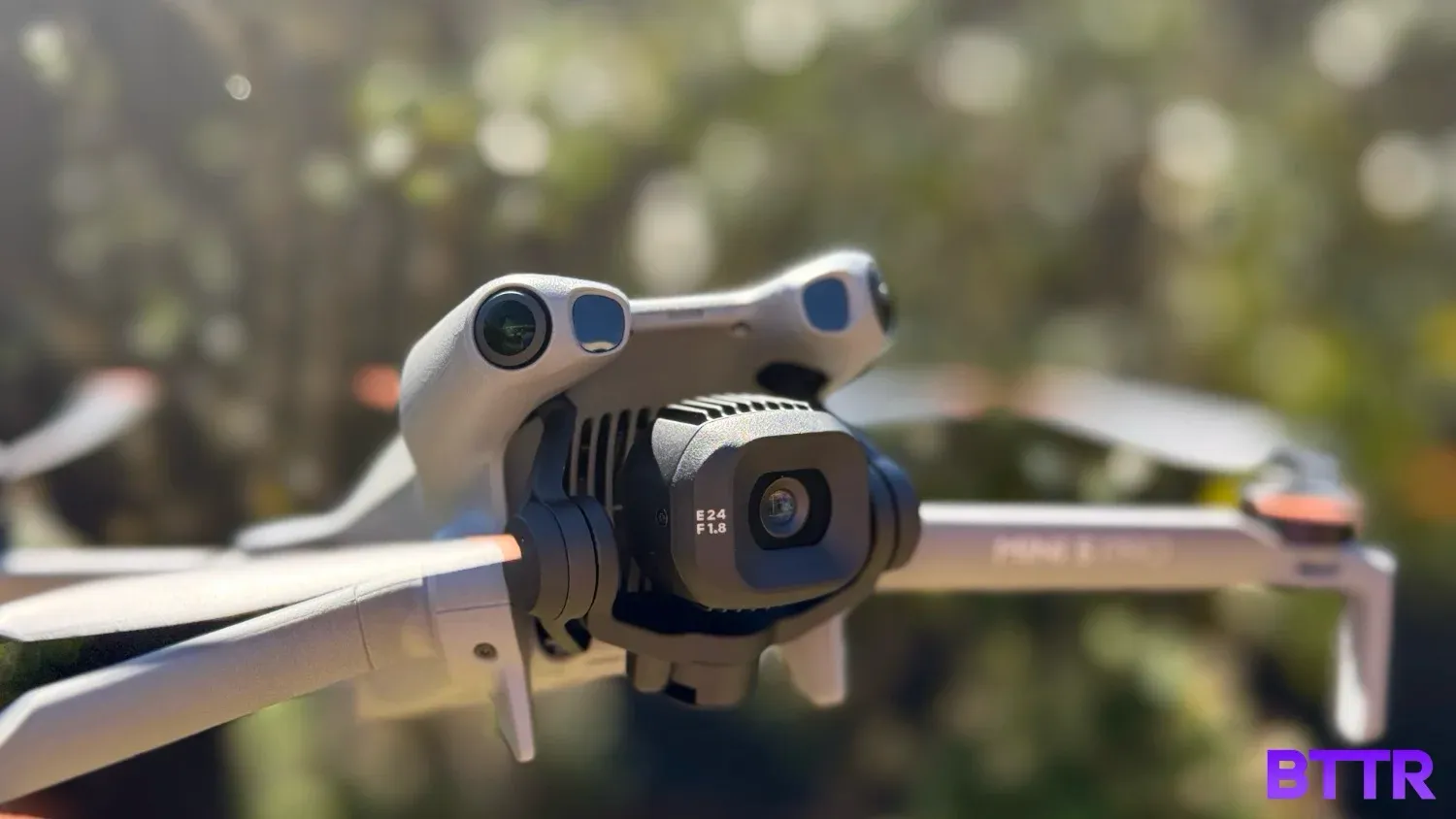
Verdict
After using the Mini 5 Pro, I still feel that the Neo is the best starting point as a first drone.
But if you’re looking to scale up from that initial investment to something with more versatility, better battery and superior image quality, the Mini 5 Pro is a no-brainer.
It delivers exceptional professional performance in a reasonably priced compact drone.
The weight issue, which sees it sit outside the sub-250 gram category, is a bit of a pain, particularly if you want to take this with you on an international trip.
But even without that confusion, DJI has delivered a really premium product here.
Buy the DJI Mini 5 Pro if:
- You’re looking to level up your existing mini-drone
- You need to fly a drone for work, and are happy to register and get accredited
- You are prepared to spend a bit of money on your droning habit
Skip the DJI Mini 5 Pro if:
- Really need that sub-250 gram take off weight
- You want something with a wide-angle and a telephoto lens
- You just want to see if you like drones
Where to buy
The DJI Mini 5 Pro comes in a few different packages, with the drone only option starting at $1,119.
Package Options and Pricing:
| Package Contents | DJI Mini 5 Pro (Standard) | Fly More Combo (RC-N3) | Fly More Combo (RC 2) | Fly More Combo Plus (RC 2) |
|---|---|---|---|---|
| RRP (AUD) | $1,119 | $1,419 | $1,699 | $1,799 |
| DJI Mini 5 Pro Drone | ✓ | ✓ | ✓ | ✓ |
| Controller | DJI RC-N3 (requires smartphone) | DJI RC-N3 (requires smartphone) | DJI RC 2 (built-in screen) | DJI RC 2 (built-in screen) |
| Intelligent Flight Battery (2,788 mAh - 36 min) | 1 battery | 3 batteries | 3 batteries | — |
| Intelligent Flight Battery Plus (4,680 mAh - 52 min) *Exceeds 250g weight limit | — | — | — | 3 batteries |
| Two-Way Charging Hub | — | ✓ | ✓ | ✓ |
| ND Filter Set (ND8/32/128) | — | ✓ | ✓ | ✓ |
| Shoulder Bag/Carrying Case | — | ✓ | ✓ | ✓ |
| Spare Propellers | 1 set (4 props) | 3 sets (12 props) | 3 sets (12 props) | 3 sets (12 props) |
| Gimbal Protector | ✓ | ✓ | ✓ | ✓ |
| USB-C Cable | ✓ | ✓ | ✓ | ✓ |
| Quick Start Guide | ✓ | ✓ | ✓ | ✓ |
| Total Flight Time (all batteries) | ~36 minutes | ~108 minutes | ~108 minutes | ~156 minutes |
Here are some of the retailers selling the DJI Mini 5 Pro online:
FAQ
Does the DJI Mini 5 Pro require registration in Australia?
The answer here is a little complicated. Technically, if you are flying the drone as a hobby, you do not need to register your drone, regardless of weight. However, the rules for drones under and over 250 grams do differ. If you are flying the drone for work, you need to register it, regardless of weight.
What's the real-world battery life of the DJI Mini 5 Pro?
While DJI advertises 36 minutes of flight time with the standard battery, real-world usage typically delivers 20–25 minutes when recording at 4K/60fps with ActiveTrack enabled. Battery life decreases further in windy conditions or when using intensive features. The optional Battery Plus extends this to approximately 40–45 minutes in real-world conditions (52 minutes maximum), but pushes the drone over 250g.
How does the DJI Mini 5 Pro perform in wind compared to larger drones?
The Mini 5 Pro is rated for wind resistance up to 12 m/s (43.2 km/h), which is adequate for most recreational flying conditions. However, its lightweight design makes it less stable in moderate to strong winds compared to heavier drones like the Mavic 3 or Air 3S. The upgraded motors in the Mini 5 Pro do provide better wind performance than previous models, but pilots should still avoid flying in gusty conditions to maintain control and image stability.
Is the 1-inch sensor in the Mini 5 Pro the same as more expensive DJI drones?
Yes, the DJI Mini 5 Pro features the same 50MP 1-inch CMOS sensor found in the Air 3S, which costs significantly more. This sensor delivers exceptional image quality with up to 14 stops of dynamic range, excellent low-light performance, and support for 4K/120fps video. This makes the Mini 5 Pro a good value proposition, offering professional-grade imaging in a package that's normally reserved for much larger, heavier drones.
What's the difference between the DJI RC-N3 and RC 2 controllers?
The RC-N3 requires you to mount your smartphone, which connects via the app to provide the live feed and controls. The RC 2 features a built-in 5.5-inch screen, eliminating phone compatibility issues, app download requirements, and battery drain on your personal device. The RC 2 offers a more seamless flying experience, though the RC-N3 is perfectly functional and helps keep costs down. There's also the premium RC Pro 2 option with a larger, ultra-bright 7-inch screen, sold separately.
Does the Mini 5 Pro's LiDAR obstacle-avoidance work at night?
Yes, the forward-facing LiDAR sensor combined with omnidirectional vision sensors enables what DJI calls "Nightscape" obstacle detection, which works reliably in low-light conditions down to 1 lux illumination. This is a significant safety upgrade over the Mini 4 Pro, allowing you to fly confidently at dusk or dawn when lighting conditions previously made obstacle avoidance less effective. The LiDAR also improves the Smart RTH (Return to Home) function by detecting obstacles along the return path, even in challenging lighting. However, if you are a recreational flyer, CASA’s drone rules only allow you to fly your drone during daylight hours.

